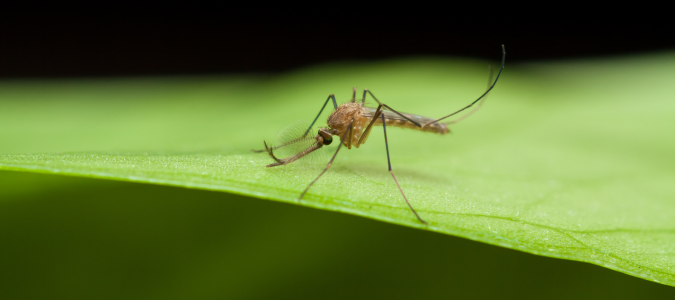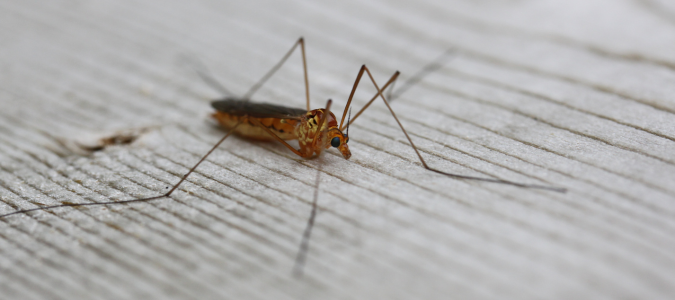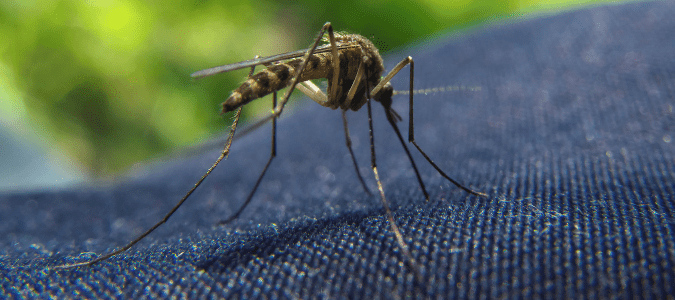It’s important for homeowners to know the difference between anopheles mosquitoes and other mosquito species, especially when it comes to their appearance and habits. Luckily, there are several ways to tell anopheles mosquitoes apart from other species.
If you have a mosquito problem on your property, it’s best to call a pest control specialist.
Identifying & Controlling Anopheles Mosquitoes
Anopheles mosquitoes differ from other species in several ways. First, their bodies are slimmer and they often position themselves at an angle. While other mosquitoes remain parallel to the ground at rest, anopheles mosquitoes perch at a 30 or 45-degree angle. They also keep this exact position when feeding on humans and animals.
Their angled position makes their body shape look like an arrow. In general, their bodies are much smaller than other mosquito species. Anopheles are black or dark brown in color, and they have three body sections: the head, thorax and abdomen.
Anopheles mosquitoes also have scaly wings that can be seen under a microscope. Like other types of mosquitoes, they have a proboscis, which is part of their mouth.
The female proboscis is sharp and pierces the skin for a blood meal. Male mosquitoes do not feed on blood, so they use their proboscis to feed on flowers.
Anopheles Mosquito Life Cycle
The life cycle of the anopheles mosquito is similar to other species in that they go through the same phases: egg, larva, pupa and adult.
Female anopheles mosquitoes lay their eggs directly on the water’s surface. The eggs have natural floating devices so that they can float separately instead of being glued together.
After a few days or weeks, the eggs hatch into larvae. In this stage, the larvae lay flat on the underside of the water’s surface, unlike other mosquito species that sit vertically under the water during this stage. This difference is because anopheles mosquitoes do not have siphons to take in air, so they must be at the surface to breathe.
After moving through four larvae phases, the mosquito molts into the pupa phase. Anopheles pupae live underwater for a few days before the fully formed adult mosquito emerges.
Adult anopheles mosquitoes use their wings to fly away to mate and eat. The entire process from egg to adult usually takes 5 to 14 days. Most male anopheles adult mosquitoes only live for one week. Females may live for up to a month, but many only live for two weeks.
However, during their short lifespans, female anopheles mosquitoes can lay 200 eggs. If you suspect you have an anopheles mosquito infestation on your property, call a pest control expert for help.
What is a Mosquito With Long Legs?
Mosquitoes are often mistaken for crane flies, which look similar to mosquitoes but have long legs. However, they are different pests. Mosquitoes are from the family Culicidae and crane flies are from the family Tipulidae. There are a few ways to distinguish crane flies from mosquitoes.
First, crane flies are typically larger than mosquitoes. They also position their bodies differently at rest. When not in motion, mosquitoes fold in their wings, and their bodies are curved. On the other hand, crane flies have straighter bodies and leave their wings out when they are at rest.
With longer legs than mosquitoes, crane flies also have a wider wingspan. However, they have other features that look the same, such as their long and thin bodies.
One of the biggest differences between the two pests is that crane flies do not need people’s blood. They prefer to live outside; however, they are attracted to light and may find themselves inside by accident. When that is the case, they will fly around looking for an exit to get back outside, whereas mosquitoes will live both indoors and outdoors if they have access to blood for reproduction.
Like mosquitoes, crane flies like living near water and lay their eggs in water. However, they do not bite humans or animals and are relatively harmless. While a crane fly infestation may become a nuisance, they do not pose the same threat as mosquitoes, which can carry diseases.
There is a misconception that crane flies eat mosquitoes. This is not true, as crane flies only feed on nectar from plants. Some adult crane flies do not feed at all during their life cycle because they only live between 2 and 15 days.
If you are unsure whether you have a crane fly or mosquito problem, call a pest control specialist. It’s important to get an expert to confirm what you are dealing with so that you can take action.
How High Do Mosquitoes Fly?
Mosquitoes do not fly as high as many people assume they do. Species that bite humans and animals prefer to fly below 25 feet to stay close to their prey. A few species will fly higher to breed and find food in trees, but otherwise, you can expect mosquitoes to stay close to the ground.
Several mosquito species also establish breeding grounds and do not like to fly too far away from the grounds.
If you have noticed mosquitoes in your home or on your property, you likely have the correct conditions to attract these unwanted pests. For example, you probably live near water or have standing water on your property where mosquitoes can lay their eggs.
All mosquito species lay their eggs in or near water because their larvae and pupae are aquatic. They need water with little movement to survive, so they are attracted to standing water on your property.
For example, a bucket of rainwater, a dog bowl or a puddle of standing water is the perfect spot for mosquitoes to reside.
How to Deter Mosquitoes
To deter these unwanted pests, get in the habit of removing standing water from your property. Once a week, turn over buckets, wheelbarrows, planters, bird baths and other water containers in your yard. Scrubbing or rinsing the containers with a hose will wash out any mosquito eggs laid that week.
If you have outdoor pets, refresh their water bowls daily and look for mosquito eggs regularly. If you see them, wash the bowls with soap and water before your pet uses them again.
Cover all storage containers, such as rain buckets and barrels, so adult mosquitoes cannot access them to lay their eggs. If you have a septic tank, look for cracks and holes and repair them immediately.
Inside your home, refresh flower water and pet bowls regularly. Install window and door screens to make it harder for mosquitoes to get in, and do not leave doors open for long periods of time.
If you have a mosquito infestation inside your home or on your property, call a pest control professional to control them.
Control Mosquitoes Today
Mosquitoes are not only annoying pests. Mosquitoes can bite dogs and cats and carry diseases like Zika virus, dengue and West Nile virus.
Knowing the difference between harmful mosquitoes and harmless pests like crane flies is also important. The sooner you know what you’re dealing with, the sooner you can start working on the problem.
Lastly, understanding mosquito habits is crucial to deterring them from your property. Eliminating water sources where mosquitoes can lay eggs is one step homeowners can take to reduce the likelihood of mosquitoes moving in. Call a pest control specialist if you have a mosquito infestation in your home or property.
ABC Can Reduce Mosquito Populations on Your Property
If you’re ready for relief from mosquitoes, contact ABC Home & Commercial Services. Our professionals will create a customized mosquito control plan. This way, you and your family can feel more at ease in your outside space again.



